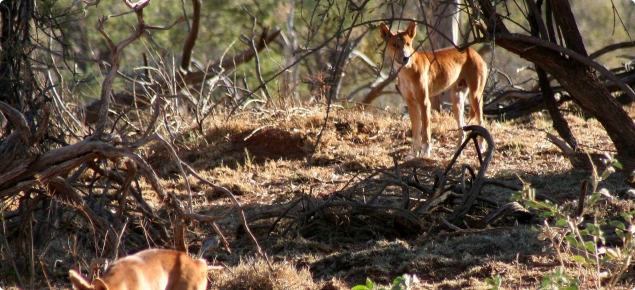Origin and description
Wild dogs are any dogs that are not domesticated. The term refers to purebred dingoes, dingo hybrids, and domestic dogs that have escaped or been deliberately released and now live in the wild. Both dingoes and wild domestic dogs are the same species, Canis familiaris.
The dingo is a primitive dog that evolved from the Indian or Pallid wolf and became widespread throughout southern Asia between 6000-10000 years ago. It is now believed that dingoes were introduced into Australia about 4000 years ago by Asian seafarers, rather than during an Aboriginal migration.
Dingoes are anatomically very similar to domestic dogs with which they are able to interbreed. They are usually sandy red or ginger in colour, with white feet and a white tail tip. White dingoes and black and tan individuals are also found. Patchy colouration or brindling is a sign of hybridisation with domestic dogs.
Habits
The diet of wild dogs is flexible; they tend to eat whatever food is available. In many parts of WA, kangaroos and emus feature prominently in the diet. Stomach analysis has also revealed insects, carrion, rabbits and some relatively rare native species.
Wild dogs are highly social animals. They live in well-defined home ranges in groups of 2-10 or more, but members of the group are seldom seen all together at any one time. Most of the time they form small, flexible sub-groups. Wild dogs sometimes hunt individually but may cooperate when chasing larger and more mobile prey such as kangaroos. Large packs or groups are seldom seen in areas where there are wild dog control activities, or an insufficent food supply.
Individual wild dogs sometimes leave their home range, probably due to social pressures. They will travel until they find suitable unclaimed territory in which to settle.
Breeding
Dingo and hybrid wild dogs differ from domestic dogs in their breeding cycle. Females have only one well defined breeding season each year. They come on heat between March and May and whelp between June and August. Litters are rarely born at other times. Sperm production in the male is also subject to seasonal fluctuations with few viable sperm produced in summer.
There is a high mortality rate among young wild dogs but those that survive may live to six or seven years. In undisturbed social groups usually only the dominant females' pups are raised each year and this tends to limit numbers. When group hierarchies are disrupted, for example, by control measures, more females may raise litters, leading to increased numbers of juveniles.

